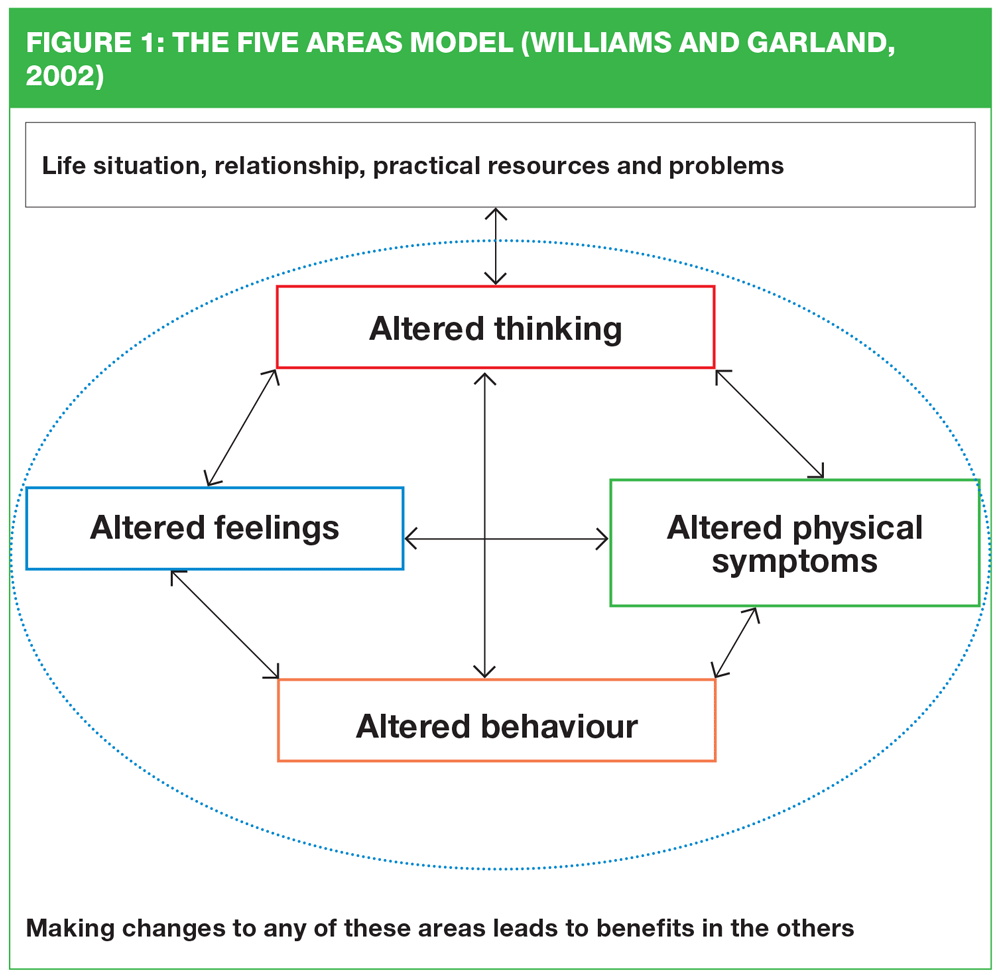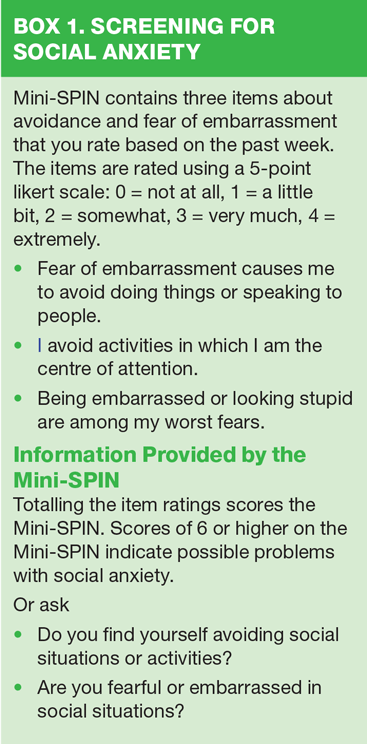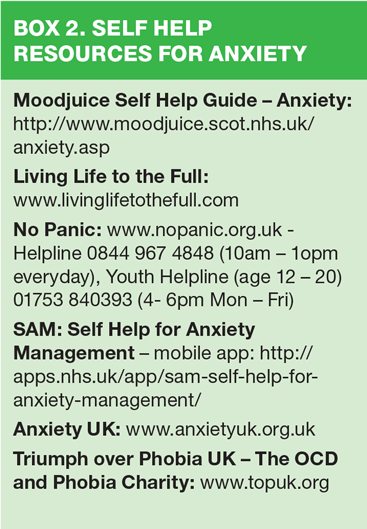
A Practice Nurse guide to common mental health problems: Anxiety disorders
Dr Mandy Fry, Portfolio GP & Oxford GP School Senior Programme Director (Retainers and GP I&R Scheme...
Dr Mandy Fry, Portfolio GP & Oxford GP School Senior Programme Director (Retainers and GP I&R Scheme)
We all suffer from irrational fears and phobias from time to time, whether of spiders or a visit to the dentist: but for some patients, anxiety can develop into a disorder with significant impact on quality of life
All of us know what it is like to feel anxious as that is part of the body’s physiological response, the ‘fight or flight reaction’ which occurs when we find ourselves in a situation of perceived threat. In this situation the activation of the sympathetic nervous system prepares the body to either react to the situation or to retreat. However, for over 3 million people in the UK1 that natural physiological response has become exaggerated so that they respond as if facing a threat when no such threat exists. Sometimes this can be related to specific situations, such as someone with a phobia of spiders, whereas for others there can be a much more widespread anxiety disorder. In each instance the person involves tends to respond by trying to avoid situations that provoke these feelings. Sometimes that is not particularly disabling, for example a person with a phobia of snakes who lives in the UK is not going to find this a particularly challenging situation to avoid. However, sometimes the ‘trigger’ is so widespread that this avoidant behaviour becomes all-consuming and makes it impossible for the sufferer to live anything resembling a normal life.
Let’s consider Jane, a 34-year-old woman. Jane had an interuterine system (IUS) fitted last year under general anaesthetic whilst undergoing a laparoscopy for possible endometriosis. At that time she had a cervical smear taken which showed Grade 1 cervical changes. The recommendation was that Jane should have annual smears for follow up initially. You notice that Jane has booked for her smear on several occasions but has then failed to attend her appointments.
It is interesting that Jane’s previous cervical smear was undertaken under a GA and it may be worth reviewing her notes to see if she has ever had a smear undertaken in primary care as part of the national screening programme. The fact that Jane has been booking appointments suggests that she is aware of the importance of this follow up and is keen to look after her health. The fact that she does not cancel the appointments but rather defaults on them is suggestive that something else may be going on, particularly if Jane does not have a habit of failing to attend other types of appointments. With the pressures on primary care it would be easy to send Jane a letter pointing out how much her actions are costing the health service and perhaps even suggesting that she would not be welcome to book another appointment. But such an approach is unlikely to help Jane and may simply exacerbate the situation to the extent that she completely fails to engage any further with the practice.
You review Jane’s notes and cannot see that she has ever had a cervical smear as part of the national screening programme. You also note that she has never failed to attend a GP appointment at the practice. When you look closely at the summary screen you notice that Jane has a past history of sexual assault. You decide to contact Jane and find out what is going on, as you suspect that this may have some bearing on the reason as to why she has failed to attend for her smear.
Sometimes anxiety about a particular situation is borne out of an exaggerated normal response to a similar situation in the past. Some patients find it helpful that they can at least see some sort of reason for their anxiety whereas others find it frustrating that they are unable to control it. In Jane’s situation you can see the possible root cause of the anxiety, but it is important not to make any assumptions. Given this history, however, it may be that not being able to tolerate a cervical smear is only one element of avoidant behaviour that Jane is showing.
On talking to Jane you sensitively explore why she has been defaulting from her cervical smear. Jane tells you that she realises how important it is but as soon as she leaves the house for her appointment she starts shaking and hyperventilating and has to go back inside. Jane is keen to try to overcome this situation and thought she could manage it but is getting increasingly frustrated with herself each time.
There are a number of options to consider here. Given that Jane will not have to undergo a cervical smear too frequently you could consider the use of a single dose of benzodiazepines to dampen down her physiological response. These drugs do still have their place and can be particularly helpful in specific phobias where it is impossible to avoid the anxiety provoking situation, such as for people with a fear of flying who still wish to visit their overseas relatives. However, they are not without their side effects, particularly drowsiness, which may well affect an individual’s ability to drive. Patients also rapidly develop tolerance to their effect and they are undoubtedly habit forming. In situations where drowsiness would be a real issue, such as an individual taking their driving test who is crippled by anxiety, an alternative solution might be a beta-blocker, such as propranolol, to dampen down some of the somatic symptoms. In this situation it would obviously be sensible to encourage the patient to take a test dose in advance of their driving test to ensure that they do not develop any adverse effects.
In Jane’s situation you could also consider some cognitive behavioural therapy (CBT), particularly if you discover that her anxiety is also affecting other situations, such as her relationships. CBT will concentrate on the ‘here and now’ seeking to challenge Jane’s thoughts and behaviours. Thinking about the ‘five areas model’2 (Figure 1) may be helpful in this regard. It may also be that she needs to try and make sense of what happened to her in the past, which may need some longer term, more psychodynamic focussed interventions.
In some ways Jane’s anxiety is a relatively easy one to understand, being borne out of a traumatic experience in the past. However it is not uncommon for phobias to develop for no apparent reason. Some people even consider that it is possible for there to be a genetic component. However, it can be difficult to distinguish this from learned behaviours: for example, if your mother is frightened of birds then the way in which she reacts to them may lead you to share her fears and develop your own phobia of birds as you grow up.
Another example of a phobia that can become incredibly isolating is the development of social phobia, whereby the individual concerned develops an intense fear of interacting with other people in a variety of social situations. It is thought that this affects up to 12% of the population.3 Obviously this can have a major impact on the relationships of affected individuals, and adversely affect their employment prospects. As it often develops in adolescence, with a median age of onset of 13 years, it can also affect school performance, which can have a pervasive effect on an individual’s future even if they recover before reaching adulthood, which is not uncommon.
Social phobia often co-exists with other mental health conditions such as depression, post-traumatic stress disorder and generalised anxiety disorder. Individuals also often seek to cope with their symptoms by turning to self-medication with drugs or alcohol and so subsequently also develop a substance misuse disorder.
Treatment with an SSRI, such as escitalopram or sertraline, can be particularly beneficial and it is sobering to consider that the majority of patients suffer for an average of 15 to 20 years before seeking treatment, and half of those who suffer never seek help at all. Being alert to the possibility of social phobia, and using screening tools, such as the mini-SPIN4 (Box 1) can help to start to address this potential iceberg of untreated distress. CBT also has a role to play, particularly involving gradual/progressive exposure in facing up to the feared situation with the support of a therapist in an attempt to desensitise to the potential stimulus.
Sometimes, however, anxiety can be less obvious in its presentation, and masquerade in the form of functional, or medically unexplained symptoms. Let’s take the example of Maud…
Maud, a 62-year-old woman, comes to the minor illness clinic complaining of a sore throat and general aches and pains. You examine her thoroughly and can find no obvious cause for her symptoms. You also note that she tends to present to the surgery every few weeks with physical symptoms for which there is no convincing medical explanation.
It is of course entirely possible that Maud is simply lonely and so she comes to the surgery for some social contact. If this is the case, the most appropriate intervention might be to refer her to a local luncheon club or befriending scheme. However, often such individuals with medically unexplained symptoms have an underlying anxiety or depressive disorder. It is important to take Maud’s complaints seriously, including carrying out an examination if appropriate, and then try to broaden out the agenda to reframe her symptoms to consider the possibility that anxiety or depression is contributing to the situation, perhaps relating this to life events. Then finally you make the link between anxiety and physical symptoms, for example, explaining that tensed muscles can cause pain. This is known as the Reattribution model5 for addressing somatoform disorders and can be incredibly helpful. In some patients this is sufficient for them to be able to manage their functional symptoms, but in others there is also a role for medication such as selective serotonin reuptake inhibitors. NICE recommends the use of citalopram or sertraline as first line options. It is worth remembering that recent MHRA advice6 limits the dose of citalopram to 20mg/day for those who are age 65 or over. Sertraline also tends to have fewer interactions with other drugs, which may be particularly relevant for older people who tend to have pre-existing co-morbidities.
Sometimes early intervention can prevent anxiety from escalating into an uncontrollable disorder that has a significant impact on an individual’s life.1 An example of this might be the patient who presents to the emergency department with chest pain and shortness of breath that is subsequently diagnosed as a panic attack. Often such individuals will be discharged home, once a serious underlying disorder has been excluded, and encouraged to contact their GP if they need further help. Many of them however will be embarrassed about their situation and so will not make contact with primary care services. Some of them will not have any further panic attacks, or at least suffer them very infrequently. Others however may go on to have recurrent issues, and then often develop anticipatory anxiety where they even become disabled between attacks by worry about the next attack coming on. Making contact with patients after their first panic attack can help to reduce the number who develop a full blown panic disorder, and such patients can often be signposted to self help strategies that they can explore (see box 2). Such interventions also help to diminish the stigma that may otherwise be associated with the discovery that their symptoms are attributable to an emotional rather than a physical disorder.
Diminishing stigma is an important role for healthcare professionals in managing individuals with anxiety related disorders. You might hope that as we all know what it is like to feel anxious that we would have empathy with individuals in this situation, but rather it seems that this familiarity can lead us to underestimate the impact it can have on an individual’s life. It also means that sufferers can themselves see having anxiety as a sign that they are unable to cope with life. This in turn leads to reluctance to seek help and so the cycle goes on. By being open to the possibility that anxiety may be playing a role in someone’s situation we can seek to break this cycle.
REFERENCES
1. NICE CG 113: Generalised anxiety disorder and panic disorder (with or without agoraphobia) in adults: Management in primary, secondary and community care, 2011. https://www.nice.org.uk/guidance/cg113
2. Williams, C.J. and Garland, A. A cognitive behavioural therapy assessment model for use in everyday clinical practice. Advances in Psychiatric Treatment, 2002;8:172-179
3. NICE CG159. Social anxiety disorder: recognition, assessment and treatment, 2013. https://www.nice.org.uk/guidance/cg159
4. Connor KM, Kobak KA, Churchill LE, Katzelnick D, Davidson JR. Mini-SPIN: a brief screening assessment for generalized social anxiety disorder. Depression and Anxiety. 2001;14:137-140.
5. Chitnis et al. Guidance for heath professionals on medically unexplained symptoms, 2011 http://www.rcpsych.ac.uk/pdf/CHECKED%20MUS%20Guidance_A4_4pp_6.pdf
6. MHRA (Dec 2011) Citalopram and escitalopram: QT interval prolongation https://www.gov.uk/drug-safety-update/citalopram-and-escitalopram-qt-interval-prolongation (accessed Sept 14 2015)
Related articles
View all Articles


